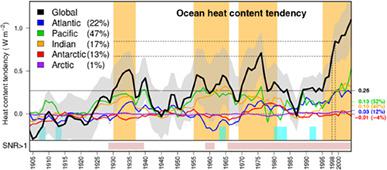当前位置:
X-MOL 学术
›
Int. J. Climatol.
›
论文详情
Our official English website, www.x-mol.net, welcomes your
feedback! (Note: you will need to create a separate account there.)
The 20th century global warming signature on the ocean at global and basin scales as depicted from historical reanalyses
International Journal of Climatology ( IF 3.5 ) Pub Date : 2021-04-29 , DOI: 10.1002/joc.7163 A Storto 1 , M A Balmaseda 2 , E Boisseson 2 , B S Giese 3 , S Masina 4 , C Yang 1
International Journal of Climatology ( IF 3.5 ) Pub Date : 2021-04-29 , DOI: 10.1002/joc.7163 A Storto 1 , M A Balmaseda 2 , E Boisseson 2 , B S Giese 3 , S Masina 4 , C Yang 1
Affiliation

|
More than 90% of excess energy trapped by greenhouse gases is accumulated in the oceans. Ocean heat content (OHC) and its changes are therefore fundamental metrics to monitor climate change. However, due to sparse observation sampling before the 1950s, accurate observation-based estimations only exist for the second half of the 20th century. A 16-member ensemble of historical ocean reanalyses is used for the first time to compile a unique estimate of 20th century oceanic warming rates. The reanalyses combine dynamical ocean general circulation models with historical observations and observation-based atmospheric forcing. Ocean heat content tendencies (OHCT) from the multireanalysis ensemble (MRE) agree well with independent estimates of ocean heat content, and show a coherent evolution with records of Earth's energy imbalance from atmospheric reanalyses and atmospheric CO2 concentration at a range of timescales. OHCT from reanalyses proves to be a more effective climate change proxy, that is, more closely related to independent climate indexes, than observed surface warming tendencies that contain high-frequency variability not related to the climate change signature, or historical coupled model simulations, which neglect interannual fluctuations. The ensemble mean estimate of the century-long ocean warming rate is 0.26 ± 0.08 W m−2. The warming rate of 0.84 ± 0.21 W m−2 estimated from 1993 onwards is unprecedented. The global decadal warming rate is persistently positive from about 1925 onwards, except for two neutral periods. The Indian Ocean exhibits the highest relative contribution to centennial heat accumulation, while the Atlantic Ocean plays an increasingly prominent role, especially during the 1995–2004 decade. These findings are in agreement with previous studies.
中文翻译:

历史再分析所描绘的 20 世纪全球和海盆尺度海洋上的全球变暖特征
超过 90% 的被温室气体捕获的过剩能量在海洋中积累。因此,海洋热含量 (OHC) 及其变化是监测气候变化的基本指标。然而,由于 1950 年代之前的观测抽样稀疏,准确的基于观测的估计仅存在于 20 世纪下半叶。首次使用由 16 名成员组成的历史海洋再分析集合来编制对 20 世纪海洋变暖率的独特估计。再分析将动态海洋环流模型与历史观测和基于观测的大气强迫相结合。来自多重再分析集合 (MRE) 的海洋热含量趋势 (OHCT) 与海洋热含量的独立估计非常吻合,并显示出与地球记录的一致演变2不同时间范围内的浓度。来自再分析的 OHCT 被证明是一种更有效的气候变化代理,也就是说,与观测到的包含与气候变化特征无关的高频变异的地表变暖趋势或历史耦合模型模拟相比,与独立气候指数的关系更密切。忽略年际波动。长达一个世纪的海洋变暖率的集合平均估计值为 0.26 ± 0.08 W m -2。升温速率 0.84 ± 0.21 W m -2估计从1993年起是前所未有的。从 1925 年左右开始,除两个中性时期外,全球十年变暖率一直为正值。印度洋对百年热量积累的相对贡献最高,而大西洋发挥的作用越来越突出,尤其是在 1995-2004 十年间。这些发现与先前的研究一致。
更新日期:2021-04-29
中文翻译:

历史再分析所描绘的 20 世纪全球和海盆尺度海洋上的全球变暖特征
超过 90% 的被温室气体捕获的过剩能量在海洋中积累。因此,海洋热含量 (OHC) 及其变化是监测气候变化的基本指标。然而,由于 1950 年代之前的观测抽样稀疏,准确的基于观测的估计仅存在于 20 世纪下半叶。首次使用由 16 名成员组成的历史海洋再分析集合来编制对 20 世纪海洋变暖率的独特估计。再分析将动态海洋环流模型与历史观测和基于观测的大气强迫相结合。来自多重再分析集合 (MRE) 的海洋热含量趋势 (OHCT) 与海洋热含量的独立估计非常吻合,并显示出与地球记录的一致演变2不同时间范围内的浓度。来自再分析的 OHCT 被证明是一种更有效的气候变化代理,也就是说,与观测到的包含与气候变化特征无关的高频变异的地表变暖趋势或历史耦合模型模拟相比,与独立气候指数的关系更密切。忽略年际波动。长达一个世纪的海洋变暖率的集合平均估计值为 0.26 ± 0.08 W m -2。升温速率 0.84 ± 0.21 W m -2估计从1993年起是前所未有的。从 1925 年左右开始,除两个中性时期外,全球十年变暖率一直为正值。印度洋对百年热量积累的相对贡献最高,而大西洋发挥的作用越来越突出,尤其是在 1995-2004 十年间。这些发现与先前的研究一致。









































 京公网安备 11010802027423号
京公网安备 11010802027423号